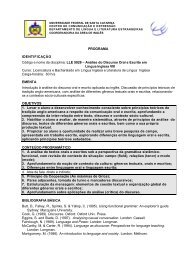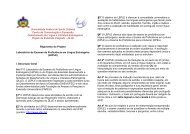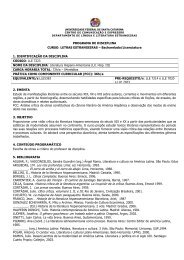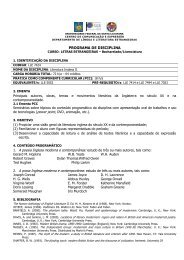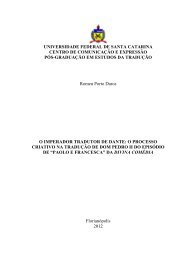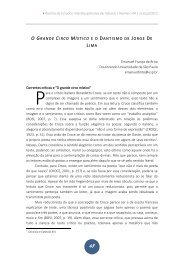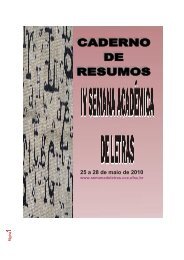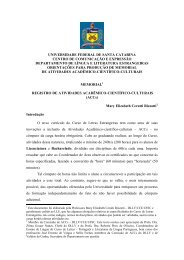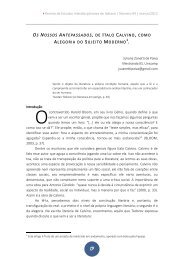Ana Amado é Professora de Análise Filmica e Teoria na ...
Ana Amado é Professora de Análise Filmica e Teoria na ...
Ana Amado é Professora de Análise Filmica e Teoria na ...
- No tags were found...
You also want an ePaper? Increase the reach of your titles
YUMPU automatically turns print PDFs into web optimized ePapers that Google loves.
paradoxically, they reject the all-encompassing figures of political mo<strong>de</strong>rnity in whichtheir parents participated in the 60s and 70s through their belief in revolution.These representations can be interpreted as signs of simultaneous autonomy and<strong>de</strong>pen<strong>de</strong>ncy regarding the filmmakers’ roots and legacies, which end in an ambiguousstance towards the political choices of their parents and their participation in this violenthistory in which the children, ultimately, became victims. The autonomy has its formalexpression in the use of the first person, in the <strong>na</strong>rrative “I” emphasized through sightand sound, the body and voice anchored in the presence of the author/<strong>na</strong>rrator/protagonist. This autonomy is also expressed through the use of graphics in the form ofsubtitles, whether used to i<strong>de</strong>ntify the convened witness—my mother, my father’scomra<strong>de</strong>, etc.—or to un<strong>de</strong>rscore the meaning of the spoken word. In Los rubios, there isa dual presence, that of Carri as <strong>na</strong>rrator and that of the actress who plays her; in M , themost recent film in this genre, director Nicolás Privi<strong>de</strong>ra plays the role of theinvestigator who becomes increasingly enraged because of the lack of answers in hisquest to find out the truth behind the disappearance of his mother. Narrative <strong>de</strong>cisionsseem to distort the axiom of French literary theorist Roland Barthes about the ten<strong>de</strong>ncyto gag the “I,” or the option of silence to <strong>na</strong>rrate history (historic <strong>na</strong>rrative is in the thirdperson; as Barthes pointed out, “No one is there to make the statement”).On the other hand, <strong>de</strong>pen<strong>de</strong>ncy is revealed in the attachment to origins, in theresurrection of an absent subject that in some cases is portrayed or emerges fitfully; anextreme example of this elision is found in Los rubios in which throughout the entiremovie no image replaces the emptiness of absence. Or the subject is evoked (invoked,<strong>na</strong>rrated, explained) by a series of witnesses that replace the absent (<strong>de</strong>ad) person who isu<strong>na</strong>ble to testify. Precisely on this point, that of the <strong>de</strong>ad witness, the stories of theorphans carry out one of the historian’s paradoxical tasks, which French philosopherMichel <strong>de</strong> Certeau <strong>de</strong>scribes as “the staging of a population of <strong>de</strong>ad people” (1993:62).Through images, texts or testimonies, literally and metaphorically, characters, i<strong>de</strong>as,places, events, situations and values are resuscitated within a historic gallery <strong>de</strong>signedby the <strong>na</strong>rrators and populated by a multiplicity of <strong>na</strong>med portraits: the ghosts of the70s.The language of theatre has operated in a similar fashion. On the local stage, the firstwas Teatro por la I<strong>de</strong>ntidad (I<strong>de</strong>ntity Theatre) which in the past <strong>de</strong>ca<strong>de</strong> has presented acycle of plays <strong>de</strong>stined to support from the realm of creativity the strategy of theGrandmothers of the Plaza <strong>de</strong> Mayo to find and i<strong>de</strong>ntify the young people who werewhisked off as babies from concentration camps by the 1976 dictatorship.A noteworthy play now being performed is Mi vida <strong>de</strong>spués (My Life Afterwards),which brings together characters from the new generation to express theirautobiographical and testimonial “I.” From this starting point, the play forms part of theuniversal ten<strong>de</strong>ncy to transform the discourse of experience into artistic work. Perso<strong>na</strong>lhistory is converted into the direct revelation of collective history. Instead ofrepresenting characters imagined by an author, the characters play themselves and telltheir own stories and those of their parents. Presented as the last link in the Biodramascycle conceived by theatre producer Vivi Tellas within the government-sponsored spaceof the San Martín Theatre in Buenos Aires, this work responds to the i<strong>de</strong>a of a cycleprecisely to make room for stories from real life.Director Lola Arias, born in 1976, is the same generation as her actors-characters. She<strong>de</strong>scribes her staging and intentions: "Six actors born in the <strong>de</strong>ca<strong>de</strong> of the 70s and the



